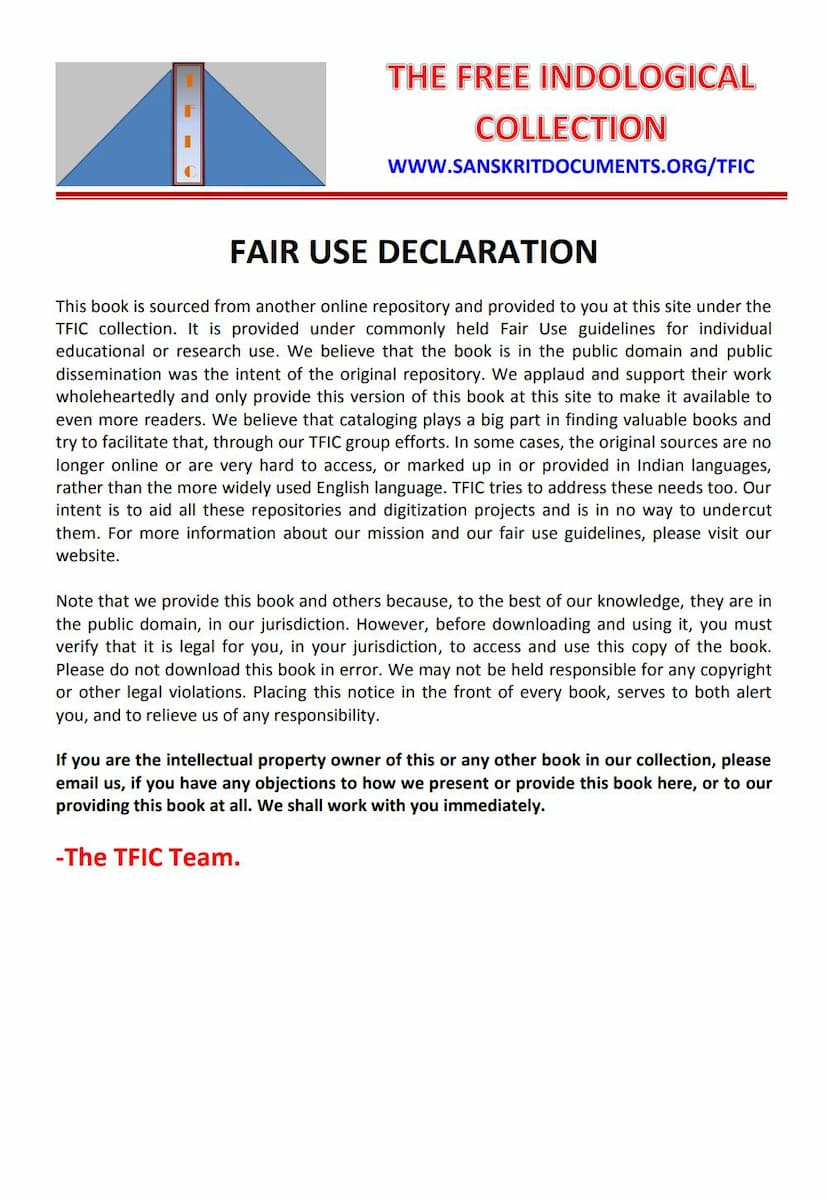Nayakarnika
Added to library: September 2, 2025

Summary
Here's a comprehensive summary of the provided Jain text, "Naya-Karnika," based on the scanned pages:
Book Title: Naya-Karnika Author: Sri Vinaya Vijaya Maharaj Editor/Translator: Mohanlal D. Desai Publisher: Kumar Devendra Prasad, The Central Jaina Publishing House, Arrah Subject: Jaina Logic, specifically the philosophy of "Nayas" (standpoints).
Overall Purpose: The "Naya-Karnika" is a primer, or introductory work, on the Jaina philosophy of Nayas. It aims to explain these different viewpoints in a clear and accessible manner, serving as a foundational text for understanding Jaina logic and metaphysics. The editor, Mohanlal D. Desai, highlights its value for its brevity and relative freedom from excessive technicalities.
Key Concepts Explained:
- Naya-Vada (Philosophy of Standpoints): This is presented as a unique and essential feature of Jaina metaphysics. The core idea is that true knowledge of any subject requires understanding it from multiple perspectives or "standpoints" (Nayas). Without this, knowledge remains partial and can lead to error and conflict, similar to the parable of the blind men and the elephant.
- Relativity of Knowledge: Jainism emphasizes that everything exists in relation to other things and is influenced by them. Therefore, complete knowledge must describe an object with reference to its various relationships. Descriptions are often from a particular viewpoint, and mistaking a partial truth for absolute truth is a common error.
- Nis'chaya Naya (Absolute/Essential Standpoint) vs. Vyavahára Naya (Practical/Conventional Standpoint):
- Nis'chaya Naya: Deals with the permanent, essential, and unchanging qualities of things. It represents the ultimate, certain truth.
- Vyavahára Naya: Deals with things based on their utility, conventional states, or non-essential aspects. It represents practical or empirical truth.
- Sub-divisions of Nayas: The text details seven principal Nayas, categorized under two broader classifications:
- Dravyárthika Naya (Substantive/General Standpoint): Focuses on general qualities and substances.
- Naigama: The non-distinguished standpoint, which considers both general and special qualities without making a clear distinction between them. It sees the concept of "bamboo" as "tree" plus "special qualities" intermingled.
- Samgraha: The collective or generic standpoint, focusing solely on general qualities. It deals with the genus.
- Vyavahára: The practical or particular standpoint, which distinguishes between genus and species, focusing on particular attributes.
- Rijusutra: The straight-expression standpoint, which considers only the present form of a thing, ignoring its past or future aspects. It emphasizes immediate utility.
- Paryáyárthika Naya (Evolutionary/Specific Standpoint): Focuses on forms, conditions, and specific attributes.
- Sabda: The verbal standpoint, which distinguishes between words based on grammatical features like gender, number, and tense, even for synonyms.
- Samabhirudha: The subtle or etymological standpoint, which distinguishes between words based on their root meanings and etymology, even if they are synonymous.
- Evambhuta: The "such-like" or functional standpoint, which recognizes a thing by a name only when it is performing its specific function indicated by that name.
- Dravyárthika Naya (Substantive/General Standpoint): Focuses on general qualities and substances.
- Fallacies (Abhasa) of Nayas: The text also outlines the common errors associated with each Naya when its principles are misapplied (e.g., taking a part for the whole, or ignoring crucial distinctions).
- Importance of Nayas for Jaina Philosophy: Nayas are presented as the foundation of Jaina logic and thought. They are crucial for understanding the doctrine of Anekanta-vada (non-absolutism or many-sidedness), which is seen as the key to true knowledge and the reconciliation of differing philosophical views. The Nayas allow for an analytical understanding of things, while the Saptabhangi (seven-fold predication) provides the synthetic summing-up of these insights.
- Seven Principles of Jainism (Tattvas): The introduction briefly lists the seven fundamental principles of Jainism: Jiva (soul), Ajiva (non-soul), Asrava (inflow of karmas), Bandha (bondage of karmas), Samvara (cessation of karma inflow), Nirjara (shedding of karmas), and Moksha (liberation). The acquisition of knowledge about these principles is aided by Pramanas (means of knowledge) and Nayas.
Author's Biographical Sketch: The book includes a biographical sketch of Sri Vinaya Vijaya Maharaj. He was a 17th-century logician and scholar, a contemporary and associate of Sri Yashovijaya. He came from a Vani family in Gujarat. The sketch details his lineage within Jain monastic orders, his extensive studies, including non-Jaina philosophies, his significant scholarly works (like "Loka-Prakasa" and "Haima-laghu-prakriya"), and his efforts to promote Jainism. His collaborative efforts with Yashovijaya, including their strategic approach to engaging with Brahmin scholars, are also mentioned.
Structure of the "Naya-Karnika" Text: The scanned pages provide the initial verses of the "Naya-Karnika" itself.
- Benediction: The work begins with a prayer to Lord Mahavira, whose gospel is described as an ocean with Nayas as streams flowing into it.
- Listing of Nayas: The text then enumerates the seven principal Nayas.
- Explanation of Nayas: Subsequent verses and their explanations systematically describe each Naya, illustrating its core principle with examples and arguments.
- Interrelation and Classification: The text discusses the interrelation of these Nayas, their purity relative to each other, and their sub-divisions. It also notes their inclusion within the broader categories of Dravyástika and Paryáyástika nayas.
- Synthesis and Conclusion: The work concludes by stating how these differing standpoints collectively serve the Jain gospel and a concluding verse by the author, Vinayavijaya, dedicating his work.
Significance: The "Naya-Karnika" is presented as a vital tool for understanding the nuanced and multi-dimensional approach of Jain philosophy. It equips readers with the conceptual framework to analyze texts and ideas from various viewpoints, thereby avoiding dogmatism and achieving a more complete and accurate understanding of reality. The editor's translation and notes make this complex philosophical system accessible to a wider audience, particularly those unfamiliar with Jainism.